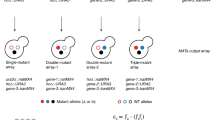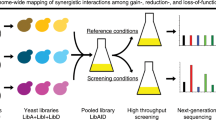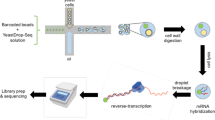Abstract
A major challenge in systems biology is to understand the gene regulatory networks that drive development, physiology and pathology. Interactions between transcription factors and regulatory genomic regions provide the first level of gene control. Gateway-compatible yeast one-hybrid (Y1H) assays present a convenient method to identify and characterize the repertoire of transcription factors that can bind a DNA sequence of interest. To delineate genome-scale regulatory networks, however, large sets of DNA fragments need to be processed at high throughput and high coverage. Here we present enhanced Y1H (eY1H) assays that use a robotic mating platform with a set of improved Y1H reagents and automated readout quantification. We demonstrate that eY1H assays provide excellent coverage and identify interacting transcription factors for multiple DNA fragments in a short time. eY1H assays will be an important tool for mapping gene regulatory networks in Caenorhabditis elegans and other model organisms as well as in humans.
This is a preview of subscription content, access via your institution
Access options
Subscribe to this journal
Receive 12 print issues and online access
$259.00 per year
only $21.58 per issue
Buy this article
- Purchase on Springer Link
- Instant access to full article PDF
Prices may be subject to local taxes which are calculated during checkout




Similar content being viewed by others
References
Walhout, A.J.M. Unraveling transcription regulatory networks by protein-DNA and protein-protein interaction mapping. Genome Res. 16, 1445–1454 (2006).
Arda, H.E. & Walhout, A.J.M. Gene-centered regulatory networks. Brief. Funct. Genomics 9, 4–12 (2009).
Deplancke, B., Dupuy, D., Vidal, M. & Walhout, A.J.M. A gateway-compatible yeast one-hybrid system. Genome Res. 14, 2093–2101 (2004).
Deplancke, B., Vermeirssen, V., Arda, H.E., Martinez, N.J. & Walhout, A.J.M. Gateway-compatible yeast one-hybrid screens. Cold Spring Harb. Protoc. doi:10.1101/pdb.prot4590 (2006).
Walhout, A.J.M. et al. GATEWAY recombinational cloning: application to the cloning of large numbers of open reading frames or ORFeomes. Methods Enzymol. 328, 575–592 (2000).
Lamesch, P. et al. C. elegans ORFeome version 3.1: increasing the coverage of ORFeome resources with improved gene predictions. Genome Res. 14, 2064–2069 (2004).
Dupuy, D. et al. A first version of the Caenorhabditis elegans promoterome. Genome Res. 14, 2169–2175 (2004).
Deplancke, B. et al. A gene-centered C. elegans protein-DNA interaction network. Cell 125, 1193–1205 (2006).
Vermeirssen, V. et al. Transcription factor modularity in a gene-centered C. elegans core neuronal protein-DNA interaction network. Genome Res. 17, 1061–1071 (2007).
Martinez, N.J. et al. A C. elegans genome-scale microRNA network contains composite feedback motifs with high flux capacity. Genes Dev. 22, 2535–2549 (2008).
Arda, H.E. et al. Functional modularity of nuclear hormone receptors in a C. elegans gene regulatory network. Mol. Syst. Biol. 6, 367 (2010).
Vermeirssen, V. et al. Matrix and Steiner-triple-system smart pooling assays for high-performance transcription regulatory network mapping. Nat. Methods 4, 659–664 (2007).
Reece-Hoyes, J.S. et al. Yeast one-hybrid assays for gene-centered human gene regulatory network mapping. Nat. Methods doi:10.1038/nmeth.1764 (this issue).
Gaudinier, A. et al. Enhanced Y1H assays for Arabidopsis. Nat. Methods doi:10.1038/nmeth.1750 (this issue).
Tong, A.H.Y. et al. Systematic genetic analysis with ordered arrays of yeast deletion mutants. Science 294, 2364–2368 (2001).
Costanzo, M. et al. The genetic landscape of a cell. Science 327, 425–431 (2010).
Venkatesan, K. et al. An empirical framework for binary interactome mapping. Nat. Methods 6, 83–90 (2009).
Hens, K. et al. Automated protein-DNA interaction screening of Drosophila regulatory elements. Nat. Methods 10.1038/nmeth.1763 (30 October 2011).
Braun, P. et al. An experimentally derived confidence score for binary protein-protein interactions. Nat. Methods 6, 91–97 (2009).
Chen, Y.C., Rajagopala, S.V., Stellberger, T. & Uetz, P. Exhaustive benchmarking of the yeast two-hybrid system. Nat. Methods 7, 667–668 (2010).
Ow, M.C. et al. The FLYWCH transcription factors FLH-1, FLH-2 and FLH-3 repress embryonic expression of microRNA genes in C. elegans. Genes Dev. 22, 2520–2534 (2008).
Reece-Hoyes, J.S. et al. The C. elegans Snail homolog CES-1 can activate gene expression in vivo and share targets with bHLH transcription factors. Nucleic Acids Res. 37, 3689–3698 (2009).
Walhout, A.J.M. What does biologically meaningful mean? A perspective on gene regulatory network validation. Genome Biol. 12, 109 (2011).
Reece-Hoyes, J.S. et al. A compendium of C. elegans regulatory transcription factors: a resource for mapping transcription regulatory networks. Genome Biol. 6, R110 (2005).
Lesch, B.J., Gehrke, A.R., Bulyk, M.L. & Bargmann, C.I. Transcriptional regulation and stabilization of left-right neuronal identity in C. elegans. Genes Dev. 23, 345–358 (2009).
Witze, E.S., Field, E.D., Hunt, D.F. & Rothman, J.H. C. elegans pur alpha, an activator of end-1 synergizes with the Wnt pathway to specify endoderm. Dev. Biol. 327, 12–23 (2009).
Tabuchi, T. et al. Chromosome-biased binding and gene regulation by the Caenorhabditis elegans DRM complex. PLoS Genet. 7, e1002074 (2011).
Hu, S. et al. Profiling the human protein-DNA interactome reveals ERK2 as a transcriptional repressor of interferon signaling. Cell 139, 610–622 (2009).
Salehi-Ashtiani, K. et al. Large-scale RACE approach for proactive experimental definition of C. elegans ORFeome. Genome Res. 19, 2334–2342 (2009).
Rajagopala, S.V., Hughes, K.T. & Uetz, P. Benchmarking yeast two-hybrid systems using the interactions of bacterial motility proteins. Proteomics 9, 5296–5302 (2009).
Rose, M. & Winston, F. Identification of a Ty insertion within the coding sequence of the S. cerevisiae URA3 gene. Mol. Gen. Genet. 193, 557–560 (1984).
Struhl, K. Nucleotide sequence and transcriptional mapping of the yeast pet56-his3-ded1 gene region. Nucleic Acids Res. 13, 8587–8601 (1985).
Scherer, S. & Davis, R.W. Replacement of chromosome segments with altered DNA sequences constructed in vitro. Proc. Natl. Acad. Sci. USA 76, 4951–4955 (1979).
Walhout, A.J.M. & Vidal, M. High-throughput yeast two-hybrid assays for large-scale protein interaction mapping. Methods 24, 297–306 (2001).
Acknowledgements
We thank members of the Walhout laboratory for discussions and critical reading of the manuscript, S. Lee for preparing media, K. Salehi-Ashtiani (Center for Cancer Systems Biology) for transcription factor Entry clones, J. Boeke for advice on the creation of Y1H-aS2, and C. Boone for general advice on the robotic pipeline and the use of different yeast strains. This work was supported by US National Institutes of Health (NIH) grant GM082971 to A.J.M.W. Research in the Dekker laboratory is supported by NIH grant HG003143 and a W.M. Keck Foundation Distinguished Young scholar award. C.L.M. and C.P. are supported by NIH grant HG005084 and US National Science Foundation grant DBI 0953881.
Author information
Authors and Affiliations
Contributions
J.S.R.-H. and A.J.M.W. conceived the project; A.K. and S.S. performed the eY1H assays; A.D. created the tools for automated eY1H assay quantification in collaboration with B.L., C.P., J.D., J.S.R.-H. and C.L.M.; S.K. cloned additional transcription factor–encoding ORFs; J.S.R.-H. and A.J.M.W. wrote the paper.
Corresponding authors
Ethics declarations
Competing interests
The authors declare no competing financial interests.
Supplementary information
Supplementary Text and Figures
Supplementary Figs. 1–6, Supplementary Tables 1–9 (PDF 92727 kb)
Rights and permissions
About this article
Cite this article
Reece-Hoyes, J., Diallo, A., Lajoie, B. et al. Enhanced yeast one-hybrid assays for high-throughput gene-centered regulatory network mapping. Nat Methods 8, 1059–1064 (2011). https://doi.org/10.1038/nmeth.1748
Received:
Accepted:
Published:
Issue Date:
DOI: https://doi.org/10.1038/nmeth.1748
This article is cited by
-
Building an improved transcription factor-centered yeast one hybrid system to identify DNA motifs bound by protein comprehensively
BMC Plant Biology (2023)
-
Transcriptional competition shapes proteotoxic ER stress resolution
Nature Plants (2022)
-
Large-scale data analysis for robotic yeast one-hybrid platforms and multi-disciplinary studies using GateMultiplex
BMC Biology (2021)
-
Essential role of a ThPOK autoregulatory loop in the maintenance of mature CD4+ T cell identity and function
Nature Immunology (2021)
-
Transcriptional regulation of nitrogen-associated metabolism and growth
Nature (2018)



